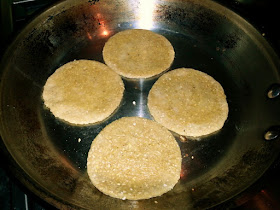Here’s the second of three herring or
mackerel roe dishes from the Saltwater
Fish part of the Fish
Chapter. I loved the first one, #159
Creamed Roe Loaves, and it was a
revelation as I had never tried them before, so I was looking forward to this.
Soft roes, sometimes called milts, are
essentially a kind of fish offal that are very much out of fashion these days. Soft
roes are the male reproductive glands; in other words, the sperm of male fish (in
contrast, females have hard roes). Gone are the days when fishmongers had a
tray of them kept aside, saved from the gutting of the mackerel and herring. My
fishmonger did have some frozen away, so you should ask yours as you never
know. Of course if you are buying several fish at the same time, you can ask
the fishmonger to put the roes aside for you and then you would have yourself
an extra meal, or at least, a garnish – you have paid for them after all!
I served this tart as a starter.
Start off by making (or – heaven forbid! –
buy) an 8 or 9 inch blind-baked shortcrust
pastry case. I made my own from 6 ounces of plain flour, 1 ½ ounces each of
salted butter and lard and a beaten egg.
Next, gently fry 4 ounces of sliced mushrooms in an ounce of butter. While they fry, prepare the
custardy roe filling. Start by pouring boiling hot water from the kettle over 8
ounces of soft herring or mackerel roes and watch them curl up
like giant snails. Leave for 3 or 4 minutes to poach.
Drain the roes and put
them into a food processor along with 2
eggs and ¼ pint of soured cream.
Blitz, taste and season with salt, black pepper, Cayenne pepper and lemon
juice. If you don’t have a food
processor, pass the roes through a sieve and stir into the remaining ingredients.
Scatter the mushrooms over the pastry base
and pour in the roe custard. Place in an oven preheated to 190⁰C (375⁰F) and
bake – it says in the book – for 35 to 40 minutes. ‘Serve hot or warm with a
tomato salad.’
#372 Soft
Roe Tart. I liked this one, though nowhere near as much as
#159 Creamed Roe Loaves that I
cooked, it seems, an age ago. The mushrooms were nice but I think the custard
needed less soured cream and more normal cream in my opinion and the cooking
time was way, way off. I checked the tart after 25 minutes and it was
over-cooked, so that was a little annoying. It’s good job roes are cheap! 6.5/10.








